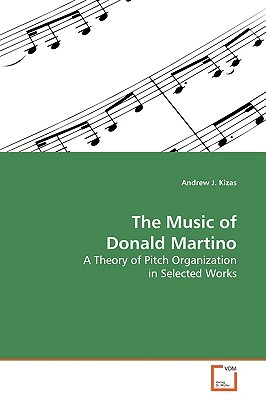
- We will send in 10–14 business days.
- Author: Andrew J Kizas
- Publisher: VDM Verlag
- ISBN-10: 3639131916
- ISBN-13: 9783639131918
- Format: 15.2 x 22.9 x 1.1 cm, softcover
- Language: English
- SAVE -10% with code: EXTRA
Reviews
Description
Donald Martino (1931-2005) has received a significant amount of recognition for his work both as a composer and a scholar. To date, however, a detailed theoretical-analytical study of Martino's music has yet to be published. Moreover, while Martino's twelve-tone compositions have received attention in the literature, his pre-dodecaphonic works have not. This is unfortunate since, as this book illustrates, Martino's pre-dodecaphonic compositions significantly inform his later works. Indeed, the present study, which traces the development of Martino's compositional technique and style from his initial experiments with octatonicism through to his mature dodecaphonic works, addresses this lacuna in the literature devoted to Martino. Pitch-class set theory and transformation theory form the theoretical basis for the analytical chapters. These theoretical perspectives are combined in order to take advantage of two different, yet complementary, modes of analysis; that is, the static classification of sets and the dynamic process of transformations.
EXTRA 10 % discount with code: EXTRA
The promotion ends in 17d.02:14:28
The discount code is valid when purchasing from 10 €. Discounts do not stack.
- Author: Andrew J Kizas
- Publisher: VDM Verlag
- ISBN-10: 3639131916
- ISBN-13: 9783639131918
- Format: 15.2 x 22.9 x 1.1 cm, softcover
- Language: English English
Donald Martino (1931-2005) has received a significant amount of recognition for his work both as a composer and a scholar. To date, however, a detailed theoretical-analytical study of Martino's music has yet to be published. Moreover, while Martino's twelve-tone compositions have received attention in the literature, his pre-dodecaphonic works have not. This is unfortunate since, as this book illustrates, Martino's pre-dodecaphonic compositions significantly inform his later works. Indeed, the present study, which traces the development of Martino's compositional technique and style from his initial experiments with octatonicism through to his mature dodecaphonic works, addresses this lacuna in the literature devoted to Martino. Pitch-class set theory and transformation theory form the theoretical basis for the analytical chapters. These theoretical perspectives are combined in order to take advantage of two different, yet complementary, modes of analysis; that is, the static classification of sets and the dynamic process of transformations.


Reviews